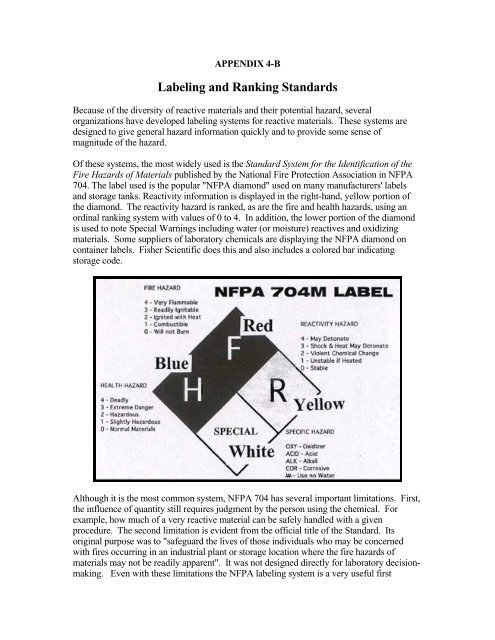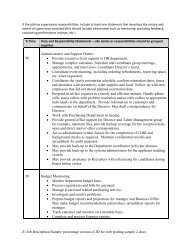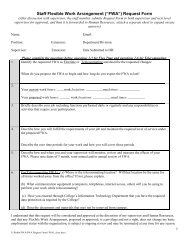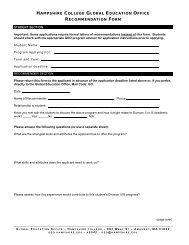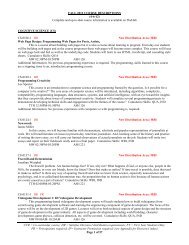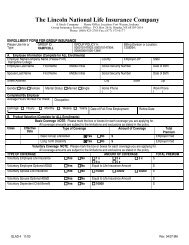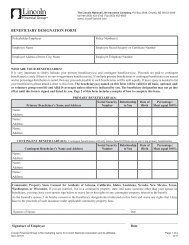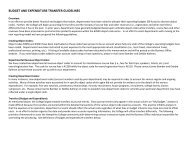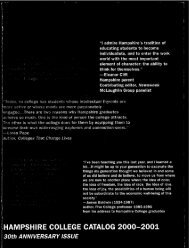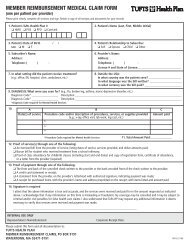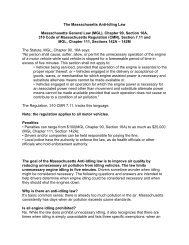Appendix 4-B
Appendix 4-B
Appendix 4-B
You also want an ePaper? Increase the reach of your titles
YUMPU automatically turns print PDFs into web optimized ePapers that Google loves.
APPENDIX 4-B<br />
Labeling and Ranking Standards<br />
Because of the diversity of reactive materials and their potential hazard, several<br />
organizations have developed labeling systems for reactive materials. These systems are<br />
designed to give general hazard information quickly and to provide some sense of<br />
magnitude of the hazard.<br />
Of these systems, the most widely used is the Standard System for the Identification of the<br />
Fire Hazards of Materials published by the National Fire Protection Association in NFPA<br />
704. The label used is the popular "NFPA diamond" used on many manufacturers' labels<br />
and storage tanks. Reactivity information is displayed in the right-hand, yellow portion of<br />
the diamond. The reactivity hazard is ranked, as are the fire and health hazards, using an<br />
ordinal ranking system with values of 0 to 4. In addition, the lower portion of the diamond<br />
is used to note Special Warnings including water (or moisture) reactives and oxidizing<br />
materials. Some suppliers of laboratory chemicals are displaying the NFPA diamond on<br />
container labels. Fisher Scientific does this and also includes a colored bar indicating<br />
storage code.<br />
Although it is the most common system, NFPA 704 has several important limitations. First,<br />
the influence of quantity still requires judgment by the person using the chemical. For<br />
example, how much of a very reactive material can be safely handled with a given<br />
procedure. The second limitation is evident from the official title of the Standard. Its<br />
original purpose was to "safeguard the lives of those individuals who may be concerned<br />
with fires occurring in an industrial plant or storage location where the fire hazards of<br />
materials may not be readily apparent". It was not designed directly for laboratory decisionmaking.<br />
Even with these limitations the NFPA labeling system is a very useful first
eference for reactivity hazards and an important emergency response information system.<br />
The following are definitions from the NFPA 704 system for reactivity.<br />
NFPA Reactivity Rating Reactivity (Stability)<br />
The assignment of degrees in the reactivity category is based upon the susceptibility of<br />
materials to release energy by themselves or in combination with water. Fire exposure was<br />
one of the factors considered along with conditions of shock and pressure.<br />
NFPA Instability (Reactivity) Rating<br />
4 Materials that in themselves are readily capable of detonation or explosive<br />
decomposition or explosive reaction at normal temperatures and pressures. This<br />
degree usually includes materials that are sensitive to localized thermal or<br />
mechanical shock at normal temperatures and pressures.<br />
3 Materials that in themselves are capable of detonation or of explosive decomposition<br />
or explosive reaction but that require a strong initiating source which must be heated<br />
under confinement before initiation. This degree usually includes: materials that are<br />
sensitive to thermal or mechanical shock at elevated temperatures and pressures;<br />
materials that react explosively with water without requiring heat or confinement.<br />
2 Materials that readily undergo violent chemical change at elevated temperatures and<br />
pressures. This degree usually includes: materials that exhibit an exotherm at<br />
temperatures less than or equal to 150 o C when tested by differential scanning<br />
calorimetry; and that may react violently with water or form potentially explosive<br />
mixtures with water.<br />
1 Materials that in themselves are normally stable, but which can become unstable at<br />
elevated temperatures and pressures. This degree usually includes: materials that<br />
change or decompose on exposure to air, light, or moisture; materials that exhibit an<br />
exotherm at temperatures greater than 150 o C, but less than or equal to 300 o C, when<br />
tested by differential scanning calorimetry.<br />
0 Materials that in themselves are normally stable, even under fire exposure<br />
conditions, and which are not reactive with water.<br />
NFPA Health Rating<br />
The assignment of degrees in the health hazard category is based upon the capability of<br />
materials to cause personal injury due to contact with or entry into the body via inhalation,<br />
ingestion, skin contact, or eye contact.<br />
NFPA Health Rating<br />
4 Materials that, under emergency conditions, can be lethal.<br />
3 Materials that, under emergency conditions, can cause serious or permanent injury.<br />
2 Materials that, under emergency conditions, can cause temporary incapacitation or<br />
residual injury.<br />
1 Materials that, under emergency conditions, can cause significant irritation.<br />
0 Materials that, under emergency conditions, would offer no hazard beyond that of<br />
ordinary combustible materials.
NFPA Flammability Rating<br />
The assignment of degrees in the flammability hazard category is based upon the<br />
susceptibility of materials to burning.<br />
NFPA Flammability Rating<br />
4 Materials that will rapidly or completely vaporize at atmospheric pressure and<br />
normal ambient temperature or that are readily dispersed in air and will burn readily.<br />
3 Liquids and solids that can be ignited under almost all ambient temperature<br />
conditions. Materials in this degree produce hazardous atmospheres with air under<br />
almost all ambient temperatures or, though unaffected by ambient temperatures, are<br />
readily ignited under almost all conditions.<br />
2 Materials that must be moderately heated or exposed to relatively high ambient<br />
temperatures before ignition can occur. Materials in this degree would not under<br />
normal conditions form hazardous atmospheres with air, but under high ambient<br />
temperatures or under moderate heating could release vapor in sufficient quantities<br />
to produce hazardous atmospheres with air.<br />
1 Materials that must be preheated before ignition can occur. Materials in this degree<br />
require considerable preheating, under all ambient temperature conditions, before<br />
ignition and combustion can occur.<br />
0 Materials that will not burn under typical fire conditions, including intrinsically<br />
noncombustible materials such as concrete, stone, and sand.


